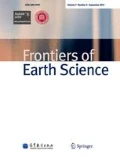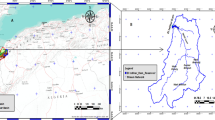Abstract
The performance of the Revised Universal Soil Loss Equation (RUSLE) as the most widely used soil erosion model is a challenging issue. Accordingly, the objective of this study is investigating the estimated sediment delivery by the RUSLE method and Sediment Delivery Distributed (SEDD) model. To this end, the Talar watershed in Iran was selected as the study area. Further, 700 paired sediment-discharge measurements at Valikbon and Shirgah-Talar hydrometric stations between the years 1991 and 2011 were collected and used in sediment rating curves. Nine procedures were investigated to produce the required RUSLE layers. The estimated soil erosion by RUSLE was evaluated using sediment rating curve data by two methods including least squares and quantile regression. The average annual suspended sediment load was calculated for each sub-watershed of the study area using the SEDD model. Afterwards, a sediment rating curve was estimated by least squares and quantile regression methods using paired discharge-sediment data. The average annual suspended sediment load values were calculated for two hydrometric stations and were further evaluated by the SEDD model. The results indicated that the first considered procedure, which utilized 15-min rainfall measurements for the rainfall factor (R), and the classification method of SENTINEL-2 MSI image for the cover management factor (C), offered the best results in producing RUSLE layers. Furthermore, the results revealed the advantages of utilizing satellite images in producing cover management layer, which is required in the RUSLE method.
Similar content being viewed by others
References
Beven K, Kirkby M J (1979). A physically based, variable contributing area model of basin hydrology. Hydrol Sci J, 24(1): 43–69
Dai Z, Fagherazzi S, Mei X, Gao J (2016). Decline in suspended sediment concentration delivered by the Changjiang (Yangtze) River into the East China Sea between 1956 and 2013. Geomorphology, 268: 123–132
Dai Z, Liu J T, Wei W, Chen J (2015). Detection of the Three Gorges Dam influence on the Changjiang (Yangtze River) submerged delta. Sci Rep, 4(1): 6600.
Dregne H E (1992). Erosion and soil productivity in Asia. J Soil Water Conserv, 47: 8–13
Eedy W (1995). The use of GIS in environmental assessment. Impact Assessment, 13(2): 199–206
Fathizad H, Karimi H, Alibakhshi S M (2014). The estimation of erosion and sediment by using the RUSLE model and RS and GIS techniques (case study: Arid and semi-arid regions of Doviraj, Ilam province, Iran). Int J Agric Crop Sci, 7: 303
Fernández C, Vega J A (2016). Evaluation of RUSLE and PESERA models for predicting soil erosion losses in the first year after wildfire in NW Spain. Geoderma, 273: 64–72
Ferro V, Minacapilli M (1995). Sediment delivery processes at basin scale. Hydrol Sci J, 40(6): 703–717
Ferro V, Porto P (2000). Sediment delivery distributed (SEDD) model. J Hydrol Eng, 5(4): 411–422
Fournier F (1960) Climate and erosion: the relationship between soil erosion by water and atmospheric precipitation. Dissertation for the Doctoral Degree. Paris: University of France
Hassan M, Roberge L, Church M, More M, Donner S, Leach J, Ali K (2017). What are the contemporary sources of sediment in the Mississippi River? Geophys Res Lett, 44(17): 8919–8924
Iikhchi A A, Hajabbassi M, Jalalian A (2003). Effects of converting range to dry-farming land on runoff and soil loss and quality in Dorahan, Chaharmahal & Bakhtiari Province. JWSS-Isfahan University of Technology, 6(4): 103–115
Koenker R (2012) Quantreg: Quantile Regression. R package version 4.98
Koenker R, Bassett G (1978) Regression quantiles. Econometrica, 46: 33–50
Lee S E, Kang S H (2014). Geographic information system-coupling sediment delivery distributed modeling based on observed data. Water Sci Technol, 70(3): 495–501
Mei X, Dai Z, Darby S E, Gao S, Wang J, Jiang W (2018). Modulation of extreme flood levels by impoundment significantly offset by floodplain loss downstream of the Three Gorges Dam. Geophys Res Lett, 45(7): 3147–3155
Minacapilli M, Santoro M (2003) Calibrating the SEDD model for Sicilian ungauged basins. Erosion Prediction in Ungauged Basins: Integrating Methods and Techniques, 279: 151
Mirakhorlo M S, Rahimzadegan M (2018). Application of sediment rating curves to evaluate efficiency of EPM and MPSIAC using RS and GIS. Environ Earth Sci, 77(20): 723
Mondal A, Khare D, Kundu S (2018). A comparative study of soil erosion modelling by MMF, USLE and RUSLE. Geocarto Int, 33(1): 89–103
Morgan R P C, Nearing M (2016). Handbook of Erosion Modelling. London: John Wiley & Sons
Renard KG, Foster GR, Weesies G, McCool D, Yoder D (1997) Predicting Soil Erosion by Water: a Guide to Conservation Planning with the Revised Universal Soil Loss Equation (RUSLE). Washington D C: US Department of Agriculture, Agricultural Research Service Washington
Renard KG, Freimund JR (1994) Using monthly precipitation data to estimate the R-factor in the revised USLE. J Hydrol (Amst), 157: 287–306
Riley S J, DeGloria S D, Elliot R (1999). A terrain ruggedness index that quantifies topographic heterogeneity. Intermt J Sci, 5: 23–27
Shiau J T, Chen T J (2015). Quantile regression-based probabilistic estimation scheme for daily and annual suspended sediment loads. Water Resour Manage, 29(8): 2805–2818
Tanyaş H, Kolat Ç, Süzen M L (2015). A new approach to estimate cover-management factor of RUSLE and validation of RUSLE model in the watershed of Kartalkaya Dam. J Hydrol (Amst), 528: 584–598
Van der Knijff J, Jones R, Montanarella L (2000). Soil erosion risk assessment in Europe. European Soil Bureau, European Commission Belgium.
Vrieling A (2006) Satellite remote sensing for water erosion assessment: a review. Catena, 65: 2–18
Wei L, Kinouchi T, Velleux M L, Omata T, Takahashi K, Araya M (2017). Soil erosion and transport simulation and critical erosion area identification in a headwater catchment contaminated by the Fukushima nuclear accident. J Hydro-environment Res, 17: 18–29
Wischmeier W H, Smith D D (1978). Predicting rainfall erosion losses—a guide to conservation planning. USDA, Science and Education Administration
Yang M, Li X, Hu Y, He X (2012) Assessing effects of landscape pattern on sediment yield using sediment delivery distributed model and a landscape indicator. Ecol Indic, 22: 38–52
Zounemat-Kermani M, Kişi Ö, Adamowski J, Ramezani-Charmahineh A (2016). Evaluation of data driven models for river suspended sediment concentration modeling. J Hydrol (Amst), 535: 457–472
Author information
Authors and Affiliations
Corresponding author
Rights and permissions
About this article
Cite this article
Mirakhorlo, M.S., Rahimzadegan, M. Evaluating estimated sediment delivery by Revised Universal Soil Loss Equation (RUSLE) and Sediment Delivery Distributed (SEDD) in the Talar Watershed, Iran. Front. Earth Sci. 14, 50–62 (2020). https://doi.org/10.1007/s11707-019-0774-8
Received:
Accepted:
Published:
Issue Date:
DOI: https://doi.org/10.1007/s11707-019-0774-8




